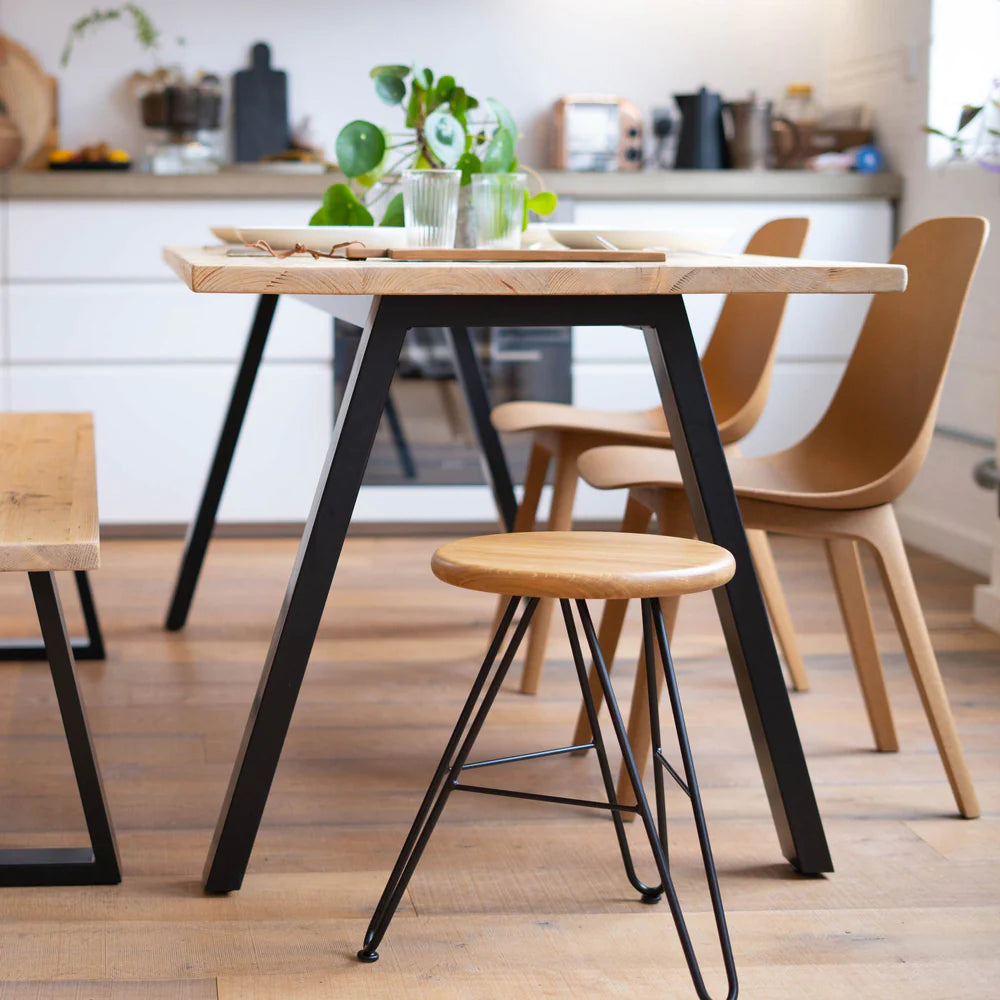A Detailed Check Out Table Leg Styles: Finding the Suitable Suit
Picking the appropriate eating table leg design is critical for both aesthetic charm and sensible performance. Traditional 4 legs supply classic beauty and security, while the pedestal base supplies boosted legroom and a modern appearance. For those with larger tables, trestle legs guarantee tough support, whereas hairpin legs present a mid-century modern-day vibe with their minimal style. The x-shaped legs mix contemporary style with improved security. Each of these alternatives brings one-of-a-kind advantages, making the option a lot more than just a matter of choice. Discover further to find which style perfectly enhances your dining space and way of life.
Standard Four Legs
Amongst the different types of eating table leg styles, the typical four-leg design remains an ageless selection for lots of families. 4 legs give well balanced support, making certain the table stays steady and capable of bearing considerable weight (dining room table legs).
From a visual point of view, the traditional four-leg design can be easily adjusted to various interior designs. Whether crafted from wood, steel, or a combination of products, these legs can be intricately sculpted, sleek and minimalistic, or anything in between. Their flexibility allows them to match both rustic and contemporary settings seamlessly.
Moreover, the straightforward structure of the four-leg design promotes simplicity of activity and placement within a space. Unlike more complicated bases, this style lessens blockages, giving sufficient legroom for restaurants. In recap, the conventional four-leg eating table leg style marries enduring sophistication with practical performance, making it an astute selection for those seeking both type and function in their dining furnishings.
Stand Base
Often commemorated for its classy and space-efficient layout, the pedestal base is a distinguished option to the traditional four-leg setup in table leg styles. This distinct base commonly features a solitary main column supporting the tabletop, which can differ in type, from ornately carved timber to streamlined, contemporary steel. One of the primary benefits of the pedestal base is its ability to maximize legroom and seating versatility. Without edge legs, restaurants are managed higher flexibility of motion, making it a perfect choice for round and oval tables that advertise even more intimate and inclusive celebrations.
Furthermore, the stand base's main support can take care of considerable weight, enabling for the use of heavier tabletops, such as marble or thick wood. This strength combined with its aesthetic adaptability makes the stand base a prominent option in both traditional and modern indoor settings. It can perfectly incorporate with different style motifs, from traditional beauty to minimalist modernity. The central column itself supplies a canvas for complex styles and imaginative expressions, adding an aspect of aesthetic interest below the table. In summary, the stand base integrates performance snappy, making it an improved and practical alternative for diverse eating atmospheres.
Trestle Legs
Trestle legs supply a robust and timeless foundation for eating tables, identified by their horizontal cross-bracing and strong support light beams. Stemming from medieval times, this design has actually developed yet kept its vital framework, making it a perennial favorite in both standard and contemporary setups. The main trestle beam of light, commonly sustained by 2 or even more upright posts, uses remarkable stability, enabling bigger table lengths without the requirement for extra legs.
A substantial benefit of trestle leg tables is the adequate legroom they use. Unlike tables with four edge legs, the absence of obstructions at the table's sides gives unimpeded room for chairs and diners, enhancing convenience and availability. This makes trestle tables optimal for fitting larger events, whether in a dining room or a reception hall.
The visual versatility of trestle legs is significant. Available in a selection of products such as timber, metal, and composite, they can be completed to match a wide variety of interior designs. From rustic farmhouse to smooth contemporary layouts, trestle legs can be tailored to suit individual tastes. Their long-lasting appeal and useful benefits make trestle legs an engaging option for those seeking Recommended Reading both style and practicality in their dining table.
Barrette Legs

The charm of hairpin legs hinges on their simplicity and convenience - dining room table legs. Offered in a variety of products, consisting of steel and brass, they can be completed in various shades to enhance various interior styles. Whether coupled with a rustic wooden tabletop or a modern glass surface, barrette legs easily mix performance with a touch of vintage charm
Longevity is an additional remarkable attribute of barrette legs. In spite of their delicate appearance, these legs are crafted to birth significant weight, making certain the dining table stays stable and safe. Furthermore, they are fairly simple to mount, making them a preferred option for DIY lovers and specialist furnishings manufacturers alike.
X-Shaped Legs

Built anchor from products such as steel, timber, or a mix of both, X-shaped legs can be customized to match various style choices. pop over to these guys Steel legs frequently provide a streamlined and commercial feeling, perfect for loft-style homes and modern dining spaces.
In addition, the design behind X-shaped legs guarantees also weight distribution, reducing the risk of tottering and enhancing longevity. This makes them especially fit for bigger eating tables that call for extra support. Fundamentally, X-shaped legs mix functional engineering with modern appearances, making them an ageless selection for varied eating environments.
Verdict
A thorough understanding of dining table leg designs exposes the unique attributes and benefits of each layout. Trestle legs make certain durable assistance for larger tables, and barrette legs present a mid-century modern-day aesthetic.